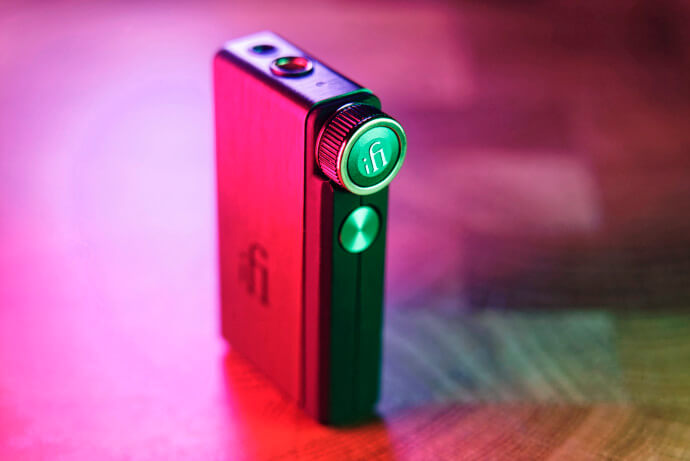Sound performances
For this review, my main sources were my iPhone and my MacBook. For headphones, I chose my old Audeze LCD-X, the AudioSense DT600, and DT200 , plus my old Sennheiser HD-800S.
I mainly used Spotify and Apple Music, but I also tried some local files, when the DAC was connected in USB.
Overall signature
So, how does the iFi GO blu fare in the long run? Pretty good and, actually, much better than I expected.
First comes power. I honestly didn’t expect the GO blu to drive my headphones with such a tiny body. Sure, numbers were promising, but expectations and reality can be two completely different things, especially in this case. Fortunately, if not deafening, the small DAC was able to deliver enough punch to push my old, but lovely, Sennheiser. Lows were a bit thin, even after I turned on xBass, but voices were spotless, and definition level was almost as good as with the Hip-Dac – but that may be the headphone.

Paired with the Meze 99 Classics, the setup feels much more adequate, and the warm signature of the Romanian headphone suits the iFi perfectly well. I mostly listen to electro tracks those days, and what I’m seeking are fast transients, quick decay, good headroom, and hard-kicking lows.
Good news, the iFi Go Blu gave me all. Yes, the soundstage seems completely unnatural once you activate XSpace, but the sound-effect was interesting enough to compensate for that. I then went back to the flat, original sound, and even like that, the DAC managed to deliver a wide space, with enough headroom to justify the amp’s addition with a phone.
The auto-gain setting seems to work well, and I never felt like I had to raise the volume more than required when switching from a headphone to an IEM. Obviously, if you can go balanced, go for it. S-Balanced is cool, but true balanced gives a lot more depth to the sound while enhancing the clarity of the signal.

I didn’t encounter any channel imbalance even at low volume and everything sounds even. Paired with the DT200, I only had to turn up the volume knob by three to four levels and the sound pressure was enough to meet my demand. Highs were a bit too brilliant, but everything else sounded quite impressive, at least as much as it’d do with a FiiO Q3 for comparison.
Finally, I did some A/B testing, plugged into my computer. The iFi GO blu didn’t need any driver and I just had to select the DAC as my output. Soundwise, there’s a clear improvement compared to the bluetooth signal, but that’s certainly due to Apple’s choice to keep AAC on their iPhone. If it goes well with the AirPods Pro and Max, on this kind of DAC, compared to the iBasso DX160 which I linked in LDAC, I felt like the overall result sounded a bit too dull.
However, the detail retrieval capability of the GO blu remained equally good and in the long run, the amp seemed to offer the right balance of fun, and accuracy. At least to my ears. Overall, a very nice experience.

Tonality
The sound signature is mostly linear, but each frequency range got its own flaws and qualities. A quick overview.
Bass: fast, accurate. The iFi GO blue isn’t a bass monster, but paired with the Meze 99 classics, the device overshadowed many similarly priced DAC/AMP in this regard. Of course, you can activate the XBass and feel the rumble, but I was keener to keep the default preset and choose a headphone/IEM with enough bass, like the Meze.
Test track : Ylang Ylang – FKJ
Mids: flat and clean. Great dynamic range combined with good power reserve makes for an impeccable medium. As expected, it’s mostly grain-less/flawless, and it sounds a lot like NuPrime’s Hi-mDAC, even if voices are slightly less natural. That said, it’s still remarkable and paired with good headphones, it shall suit your need at every moment.
Test track : Customer is King – Meute
Highs: sometimes too bright. If everything seems flat most of the time, on some headphone I noticed a slight peak around 6-7kHz. It mostly appeared when I used my iPhone so it might be a limitation of the AAC codec, but if you’re sensitive to bright highs, you should give this DAC a check first.
Good test track : The Spoils – Massive Attack

Conclusion
Let’s make it short: for the price, the iFi GO blu is a very compelling device. Build quality is great, the sound is impressive, I/O is complete thanks to 3.5 + 4.4mm headphones out, and it can virtually work with everything you own, as a DAC/Amp.
If you don’t want to get a TWS or just want something powerful, but small enough to drive your headphone on the go, the GO blu can be an excellent solution. Its versatility is gold and most of all, it’s really, really tiny, so you can fit it almost anywhere in your gear pack. Big kudos.
And so, the iFi GO blu goes right into my recommendation list, as one of the best, and swiftest solutions for audiophiles on the go. Our full list of recommendations is available here: https://www.headfonia.com/best-wireless/

________
Page 1: iFi, iFi Products, GO blu
Page 2: Design & Build Quality
Page 3: UI & Usage
Page 4: Specifications
Page 5: Sound performances








Adi
How does this compare to the BTR5?